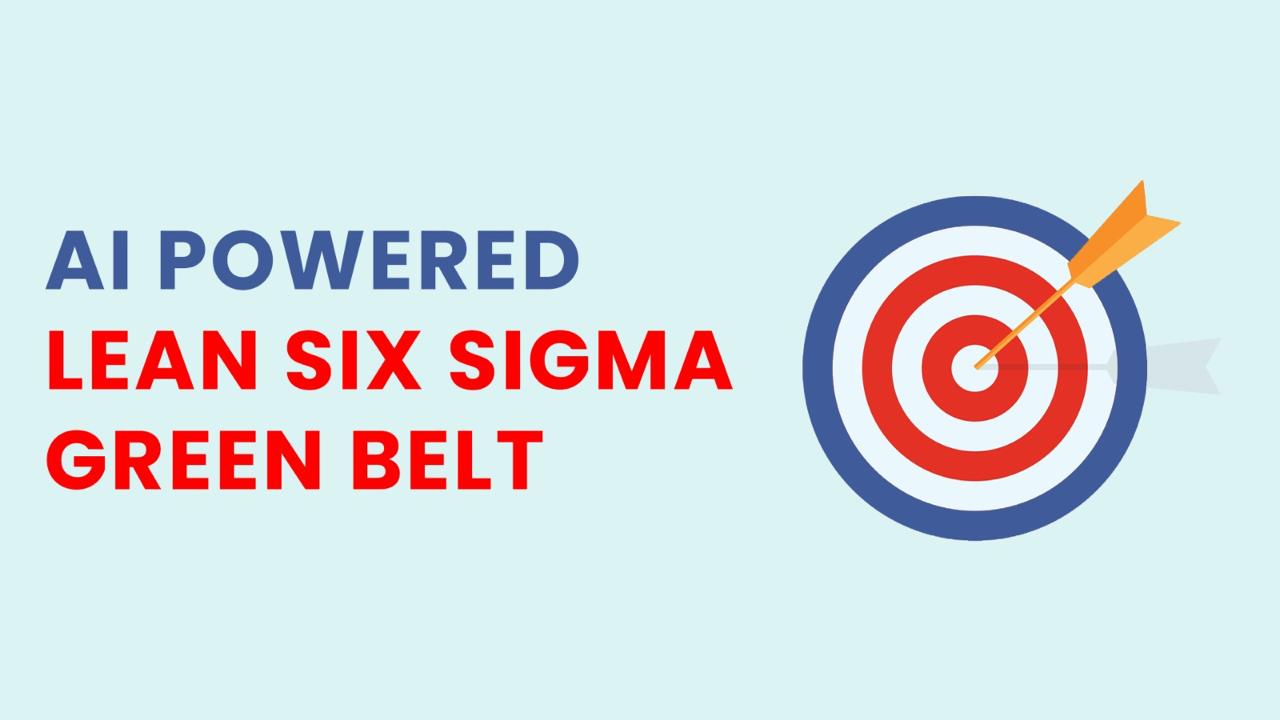
Instructor-Led Lean Six Sigma Green Belt Training & Certification | AI-Powered
July
40 Hours of Instructor-Led Online Training & Project Mentoring along with 24+ Hours of High-Quality E-Learning.
Instructor-Led Online Training
Instructor-Led Online Training
| Sun |
|---|
| 20 |
| Sat |
|---|
| 26 |
| Sun |
|---|
| 27 |
| Sat |
|---|
| 02 |
| Sun |
|---|
| 03 |
| Sat |
|---|
| 09 |
| Sun |
|---|
| 10 |
| Sat |
|---|
| 16 |
| Sun |
|---|
| 17 |
| Sat |
|---|
| 23 |
| Sun |
|---|
| 24 |
1. E-Learning
₹4,800
2. Option 1 + Live Training & Project Mentoring
₹12,800
2. Option 1 + Live Training & Project Mentoring
₹16,800
September
40 Hours of Instructor-Led Online Training & Project Mentoring along with 24+ Hours of High-Quality E-Learning.
Instructor-Led Online Training.
Instructor-Led Online Training.
| Sun |
|---|
| 07 |
| Sat |
|---|
| 13 |
| Sun |
|---|
| 14 |
| Sat |
|---|
| 20 |
| Sun |
|---|
| 21 |
| Sat |
|---|
| 27 |
| Sun |
|---|
| 28 |
| Sat |
|---|
| 04 |
| Sun |
|---|
| 05 |
| Sat |
|---|
| 11 |
| Sun |
|---|
| 12 |
1. E-Learning
₹4,800
2. Option 1 + Live Training & Project Mentoring
₹12,800
2. Option 1 + Live Training & Project Mentoring
₹16,800
Everything You Need to Know About the Instructor-Led Lean Six Sigma Green Belt Training & Certification | AI-Powered Program

Instructor-Led Lean Six Sigma Green Belt Training & Certification | AI-Powered
If you're a professional ready to accelerate your career, make data-driven decisions, and lead high-impact process improvements, this is the opportunity you've been waiting for.
This isn't just another certification. This is India’s first AI-enabled Lean Six Sigma Green Belt training, combined with hands-on project mentoring that guarantees real learning and real transformation.
You’ll gain more than just textbook knowledge—you’ll learn from real-world experience delivered by Mr. Srinivas T V, a globally respected Operational Excellence consultant. With a proven track record of mentoring over 400 successful projects and delivering $40+ million in business impact across industries, Srinivas brings deep expertise to every session. His passion for empowering professionals has made him a highly sought-after trainer by Fortune 50 companies and global organizations. He has successfully trained over 12,000 professionals worldwide and conducted high-impact corporate training for industry leaders including Amazon, Google, Mercedes-Benz, Grant Thornton, Bosch, Prestige Group, HP Inc., HPE, Thomson Reuters, Cognizant, Wipro, Adani Group, and many more.
🎯Why Choose Our Lean Six Sigma Green Belt Online Course?
✅ World's First AI-Enabled LSS Training
Harness the power of AI tools integrated into your learning, making concepts intuitive and application-ready.
✅ Learn from Industry Veteran: Mr. Srinivas T V
With over 400+ projects mentored and $40+ million in business savings, Srinivas brings 22+ years of corporate experience into the classroom. His passion for teaching, combined with real-world case studies, makes learning clear, practical, and powerful.
✅ Project Mentoring That Delivers
Go beyond theory. Get hands-on mentoring for your projects so you can implement what you learn—and showcase real business value at your workplace.
✅ Career Growth That Speaks for Itself
Professionals trained under Srinivas have experienced up to 5x career growth through better roles, promotions, and performance visibility.
✅ Participants Feedback
I had the opportunity to upskill myself in Lean Six Sigma by getting trained and certified through Lean6SigmaPro. Srinivas is the founder of Lean6SigmaPro, and he himself conducts the training. When a founder is involved, the passion and commitment are at a different level. Srinivas not only has in-depth knowledge and understanding of the subject but also extensive practical experience in implementing it. This makes the training very practical and easy to grasp. This was also evident when we went through a case study of an actual consulting and implementation done by Lean6SigmaPro. Another quality of Srinivas that struck me was his willingness to explain the concepts over and over again till each one of the participants understood it. All this with his high level of energy and enthusiasm in each and every session. It was a great experience,e and I would highly recommend Lean6SigmaPro if you are looking for any training or consulting in Lean Six Sigma.

The training methodologies used by Lean6SigmaPro are wonderfully curated. Each and every concept is directly related to real-life industrial experiences. Their specially designed training material is appreciated. Overall, I had a really good experience with them learning Lean Six Sigma. The best part is, even after our certification is done, we can always write to them or consult them for further queries or doubts.

I had attended the online LSSGB(Apr-2020) training provided by Mr Srinivasan. The course content and training material are much better in comparison to industry peers. The best thing about Mr. Srinivasan is his intention to teach. Trust me, it's rare these days. He will put his 100% into teaching you, which a student can actually feel. If someone is looking for knowledge, I would recommend Xergy. One can easily prepare for ASQ GB after attending Xergy training. Thanks a lot, Srini 😊 Strongly recommend Lean6SigmaPro!
 Gaurav Vyas
Gaurav Vyas

Researched for almost 3 months to land at a perfect destination, named Lean6SigmaPro for my LSSGB Course. Would like to bring up about few points that impressed me a lot. 1) Abundance of knowledge and passion of Mr Srinivas. He is a master in relating the topics of Six Sigma to real-time scenarios. Which becomes easy for the audience to connect. 2) The Methodology for getting the Case study into the training. Which was really good and successfully driven. Made life a lot easier. 3) Training hours would sound big, but a lot of hard work has gone in from the Lean6SigmaPro Team to make sure that every topic is dealt with clearly and given equal weightage. 4) Std Templates, which the team has, are immense for any problem-solving. You name it, they have it. Had a good time and learning during the Course. Waiting to finish with a few projects and get into the Black Belt Course. Thanks again!! -
 Shreyas Upadhyaya
Shreyas Upadhyaya

Duration
- 40+ Hours of Instructor-Led Online Training + Project Mentoring
- 24+ Hours of high-quality E-learning (Lifetime access)
Certification
- TÜV SÜD
- Exemplar Global.
Objective
Who Should Attend?
- Professionals with 0-20 years of experience
- Graduates/postgraduates from any discipline
- Any professionals seeking to accelerate his/her corporate career
- Anyone who wants to consider Lean Six Sigma as their career option
- Certified Green Belts, Black Belt want to equip themselves to drive projects
- Professionals seeking Lean Six Sigma knowledge rather than just certification
Trainers Profile
- Certified Master Black Belt & die-hard fan of Lean Six Sigma
- Over 22 years in the field of Lean Six Sigma
- Full-time consultant & passionate trainer
- Executed/Mentored over 400 Lean Six Sigma projects with $40+ savings
- Trained over 12,000 professionals across industries
- Corporate Lean Six Sigma trainer for Fortune 50 companies
Srinivas TV - Click to view full profile
Course Fee Includes
- 40+ hours of instructor-led, training with project mentoring
- Lifetime access to 24+ Hours of E-learning content
- PDF copy of Lean Six Sigma Green Belt training material
- Industry-specific case studies with data points for practice
- 80+ Lean Six Sigma Templates for project practice
- Real-Life data points for Minitab practice (unlimited)
- Sample question papers with solutions
- Post training support for executing LSS projects
- Refresher training at no charge
- Exclusive invite to attend Green Belt project presentations
- Mentorship & assistance to accelerate your corporate career
- Pay just the differential amount when you take up Lean Six Sigma Belt training in the future
- 100% Placement assistance
Course Program
- 1.0 Introduction to Lean
- 2.0 What is Lean & Application of Lean
- 3.0 6S Before Lean(Simulation to Understand)
- 4.0 Types of Waste–(Videos &Simulation to Understand)
- 4.1 Different Types of Wastes
- 4.2 Causes of Waste
- 4.3 Remedies of Waste
- 5.0 Lean Principles Introduction
- 5.1 Identify Customers & Specify Value
- 5.2 Value Stream Mapping
- 5.3 Create Flow
- 5.4 Respond to Pull
- 5.5 Pursuit Perfection
- 6.0 Identify Customers & Specify Value
- 6.1 Customer–Internal & External
- 6.2 Value Added & Non-Value Added
- 7.0 Create Value Stream Mapping (VSM)
- 7.1 Terminologies (CT, FTY, RTY, CO, TPT, WIP, WIQ)
- 7.2 Process Efficiency
- 7.3 Customer Takt time
- 7.4 Create VSM
- 7.5 Process Efficiency
- 8.0 Create Value Stream Design (VSD)
- 9.0 Create Flow & Respond to Pull
- 9.1 Single Piece Flow
- 9.2 Single Minute of Exchange of Dies
- 9.3 Line Balancing
- 9.4 Kanban (Pull Production)
- 9.5 Heijunka (Production Levelling)
- 9.6 Just In Time
- 10.0 Additional Lean Tools
- 1.0 Introduction to Quality
- 2.0 Quality Leaders (Juran, Deming, Shewhart, Ishikawa) (Videos to Understand)
- 3.0 Cost of Quality (COQ)
- 4.0 Cost of Poor Quality (COPQ) (Videos to Understand)
- 5.0 Optimum Quality Levels
- 6.0 Kano Model (Practice to Understand)
- 7.0 History & Evolution of Six Sigma
- 8.0 Continuous Improvement
- 9.0 Six SigmaApplications
- 10.0 Types of Six Sigma Projects
- 10.1 DMAIC
- 10.2 DFSS / DMADV / IDOV
- 1.0 Voice of Customer & Business(Simulation to Understand)
- 1.1 Collect Customer & Business Voices
- 1.2 Eliminate Vagueness Ambiguity
- 1.3 VOC Clarity Table
- 2.0 Customer Requirements to Process Requirements
- 2.1 Critical to X (X-Quality, Cost, Safety, or any other)
- 3.0 Project Section & Prioritisation (Practice to Understand)
- 4.0 Process Owners & Stakeholder Analysis
- 5.0 Project Charter (Practice to Understand)
- 5.1 Business Case
- 5.2 Problem Statement
- 5.3 Project Goal Statement
- 5.4 Project Team
- 5.5 Project Timeline
- 5.6 Project Scope
- 5.7 Expected Benefits
- 5.8 Project Communication
- 6.0 SIPOC & Process Mapping (Simulation to Understand)
- 7.0 Project Toll Gate Review
- 1.0 Types of Data & Measurement Scale
- 1.1 Continuous (Variable) Data
- 1.2 Discrete (Attribute) Data
- 2.0 Population & Sampling
- 2.1 Basics of Sampling
- 3.0 Type of Samples
- 3.1 Random Sample
- 3.2 Systematic Sample
- 3.3 Stratified Sample
- 4.0 Basics of Statistics
- 4.1 Central Tendency
- 4.2 Dispersion
- 4.3 Proportion
- 5.0 Introduction to Statistical Software (Minitab)
- 5.1 Minitab Practice
- 5.2 Descriptive Statistics
- 3.3 Inferential statistics
- 6.0 Normal Distributions (Practice to Understand)
- 7.0 Measurement & Data Collection
- 7.1 What is Measurement
- 7.2 Operation Definition
- 7.3 Data Collection Plan
- 8.0 Variation & Measurement System Analysis
- 8.1 Understanding Variations
- 8.2 Measurement System Analysis (MSA)
- 8.2.1 Discrimination
- 8.2.2 Accuracy
- 8.2.3 Precision
- 8.2.4 Stability
- 8.3 GRR for Continuous Data
- 8.4 Kappa Analysis
- 8.5 Control Charts & Stability
- 9.0 Baseline Process Performance (Practice to Understand)
- 9.1 Baseline Discrete Data (DPU, DPO, DPMO)
- 9.2 Baseline Continuous Data (Cp, Cpk, Pp, Ppk, Cpm)
- 10.0 Process Capability for Normal Data (Practice to Understand)
- 1.0 Identify Potential Causes (Practice to Understand)
- 1.1 BrainStorming
- 1.2 Cause & Effect Diagram
- 1.3 Five Whys Analysis
- 2.0 Process Analysis
- 2.1 Value Stream Mapping (Recap from Lean)
- 3.0 Data Analysis
- 4.0 Graphical Analysis (Practice to Understand)
- 4.1 Pareto
- 4.2 Scatter Plot
- 4.3 Box Plot
- 4.4 Histogram
- 4.5 Time Series Plot
- 4.6 Run Chart
- 4.7 Normality (using Minitab)
- 4.8 Graphical Summary
- 5.0 Normal Curve & Normality Test(Practice to Understand)
- 6.0 Confidence Interval, Risk, P value
- 7.0 Hypothesis Testing -Null & Alternate
- 8.0 Alpha & Beta Risks (Practice to Understand)
- 9.0 Hypothesis with Normal Data(Practice to Understand)
- 10.0 Hypothesis with Non-Normal Data(Practice to Understand)
- 11.0 Hypothesis with Discrete Data (Practice to Understand)
- 12.0 Correlation & its Terminologies
- 13.0 Linear Regression Analysis (Practice to Understand)
- 14.0 ANOVA
- 1.0 Generate & Evaluate Ideas (Simulations to Understand)
- 1.1 Brain Storming
- 1.2 SCAMPER
- 1.3 Lean Solutions
- 2.0 Selecting the Best Solution (Practice to Understand)
- 2.1 Multi-Voting
- 2.2 Pay-off Matrix
- 3.0 Error Proofing
- 3.1 Prevention & Detection
- 3.2 Mistake Proofing &Examples
- 4.0 Assess Risk Failure Mode and Effect Analysis (FMEA)
- 4.1 Process FMEA
- 5.0 Piloting & Implementation
- 6.0 Implementation
- 1.0 What is Process Control?
- 2.0 Different Types of Process Controls
- 3.0 Statistical Process Control (Practice to Understand)
- 4.0 Control Plan
- 5.0 Project Closure
- 6.0 Celebration
- 1.0 Introduction to Artificial Intelligence
- 1.1 Overview of AI
- 1.1.1 Definition and types of AI (Narrow, General, and Super AI)
- 1.1.2 History and Evolution of AI
- 1.2 Key AI Technologies
- 1.2.1 Machine Learning
- 1.2.2 Deep Learning
- 1.2.3 Natural Language Processing
- 1.2.4 Computer Vision
- 2.0 Integrating AI with Lean Six Sigma
- 2.1 AI in Project Discovery & Definition
- 2.2 AI in Data Collection and Measurement
- 2.3 AI in Data Analysis and Insights
- 2.4 AI in Improvement and Optimization
- 2.5 AI in Identifying Control Mechanism
Course Program Comparision
|
Lean6SigmaPro
|
Tuv Sud
|
IASSC
|
ASQ
|
Exemplar Global
|
KPMG
|
|
|---|---|---|---|---|---|---|
| Introduction to Lean | ||||||
| What is Lean & Application of Lean | ||||||
| 5S Before Lean(Simulation to Understand) | ||||||
| Types of Waste–(Videos &Simulation to Understand) | ||||||
| Different Types of Wastes | ||||||
| Causes of Waste | ||||||
| Remedies of Waste |
Certification Procedure
Exemplar Global
-
Mandatory Training Hours:
Attend instructor-led online training
-
Pass Criteria:
Successfully clear the online or paper-based exam with a score of 70% or higher
-
Lean6SigmaPro Support:
End-to-end support to appear for the Exam & Certification
-
Additional Fee:
NA
TÜV & SÜD
-
Mandatory Training Hours:
Attend instructor-led online training
-
Pass Criteria:
Successfully clear the online or paper-based exam with a score of 70% or higher
-
Lean6SigmaPro Support:
End-to-end support to appear for the Exam & Certification
-
Additional Fee:
NA
ASQ
-
Mandatory Training Hours:
Attend online/classroom training
-
Pass Criteria:
Successfully clear the online or paper-based exam
-
Lean6SigmaPro Support:
End to End support to appear for exam
-
Additional Fee:
As per ASQ exam fee (Approx. Rs.. 32,000)
IASSC
-
Mandatory Training Hours:
Attend online/classroom training
-
Pass Criteria:
Successfully clear the online or paper-based exam with a score of 70% or higher
-
Lean6SigmaPro Support:
End to End support to appear for exam
-
Additional Fee:
As per the IASSC exam fee (Approx. Rs 21,000)
Certification Criteria
Exemplar Global
-
Pre-requisite:
Graduate & Complete more than 22 hours of LSS GB training -
Examination (Computer):
50 questions -
Exam time (Computer):
75 mins -
Examination (Paper & Pen):
50 questions -
Exam time (Paper & Pencil):
75 min -
Recertification:
NA
TÜV & SÜD
-
Pre-requisite:
Graduate & Complete more than 22 hours of LSS GB training -
Examination (Computer):
50 questions -
Exam time (Computer):
75 mins -
Examination (Paper & Pen):
50 questions -
Exam time (Paper & Pen):
75 min -
Recertification:
NA
IASSC
-
Pre-requisite:
Graduate & Complete LSS GB training -
Examination (Computer):
100 questions (achieve min. 70% -
Exam time (Computer):
3 Hours -
Examination (Paper & Pencil):
100 questions (achieve min. 70%) -
Exam time (Paper & Pencil):
3 hours -
Recertification:
Every 3 years
ASQ
-
Pre-requisite:
3 years (full time paid role) in one or more areas of the green belt body of knowledge -
Examination (Computer):
110 questions (100 (scored) + 10 (unscored)) -
Exam time (Computer):
4hr 30 min -
Examination (Paper & Pencil):
100 questions -
Exam time (Paper & Pencil):
4 hours -
Recertification:
Every 3 years
Our Courses
- Quality Control
- Ai-Driven Failure Mode & Effect Analysis
- Lean Management
- Instructor-Led Lean Six Sigma Yellow Belt Training & Certification | AI-Powered.
- Instructor-Led Lean Six Sigma Green Belt Training & Certification | AI-Powered
- Instructor-Led Lean Six Sigma Black Belt Training & Certification | AI-Powered
- Six Sigma Yellow Belt
- Six Sigma Green Belt
- Six Sigma Black Belt
- Integrated Lean Six Sigma Green Belt + Black Belt
- Integrated Six Sigma Green Belt + Black Belt
- Lean Six Sigma Consultant Program
- PMP - Project Management Professional
- Theory Of Constraints
- Statistical Process Control
- Minitab Mastery
- Lean Six Sigma Project Mentoring
- Instructor-Led Lean Six Sigma Master Black Belt Training & Certification | AI-Powered
- 5S Methodology
- Eight Wastes of Lean (Service & Manufacturing)
- Eight Wastes of Lean (Manufacturing Industry)
- Value Stream Mapping (Service)
- Value Stream Mapping (Manufacturing & Service)
- Kanban and Supermarket
- Total Productive Maintenance
- Quality Function Deployment
- Process Mapping
- Cause & Effect Diagram
- Population and Sampling
- Graphical Analysis
- Hypothesis Testing
- Advanced Hypothesis Testing
- Measurement System Analysis
- Sampling Distributions
- Capability Analysis
- Design of Experiments
- Taguchi Designs
- AI-Driven Kaizen Training and Certification Program
Lean6SigmaPro: Lean Six Sigma Green Belt
Very carefully designed course to help you master the fundamentals of mighty Lean & Six Sigma and impart the skills required for you to apply the learnings at your respective workplace & able to drive Lean Six Sigma projects.
6 Reasons to choose Lean6SigmaPro
Help you make the optimal use of AI in LSS projects
Project - enabled learning & practice with indusrty data
Post - certification support, career guidance & assistance
Learn from the best consultants & LinkedIn top voices
Internationally recognized Certificates: TUV SUD or Exemplar Global
100% Certification guaranteed + Project Certificate
Instructor-Led Lean Six Sigma Green Belt Training & Certification | AI-Powered course Feedback from Participants
Please contact us via below from for more info
Google Reviews
Get in Touch with Us for Lean Six Sigma Training & Enquiries
Call us at +91 968 698 7766
Write to us at info@xergy.co.in
Explore other Lean Six Sigma certifications
Lean Six Sigma: Quality Control & Improvement
The 7 Basic Quality Tools, also known as the 7 QC tools, are crucial for resolving quality-related issues and essential in many industries. To...
Lean more >AI-Driven Failure Mode Effects Analysis (FMEA)
Failure Mode and Effects Analysis (FMEA) methods have gained popularity for over 40 years. In recent years, the use of FMEAs has gained popularity as a quality improvement tool. Someone who knows FMEA...
Lean more >Lean Management Certification & Training Course
Lean is mighty. It can accelerate your corporate career ten times within a short period. We at Lean6SigmaPro understand this. Lean6SigmaPro's simulation-enabled Lean Management training provides you w...
Lean more >Instructor-Led Lean Six Sigma Yellow Belt Training & Certification | AI-Powered
Problem solvers grow multi-fold faster in their corporate careers. The ability to solve problems systematically and effectively is the real secret to corporate growth, innovatio...
Lean more >Lean Six Sigma Green Belt FAQs
Lean is a systematic method for waste elimination or minimization with the intent to increase process efficiency and performance gain. Waste is that for which the customer is not willing to pay.
Six Sigma is a disciplined, data-driven approach and methodology to reduce variation in processes that enhance the system's performance, and directly or indirectly translates into customer satisfaction and significant financial gain.
Lean Six Sigma uses the concepts of both Lean & Six Sigma to drive significant business results. Most projects can be executed with the Six Sigma DMAIC or DMADV methodology. It is useful to apply Lean concepts on a need basis.
The Lean Six Sigma Green Belt certification is valuable when backed by practical knowledge. A certified Lean Six Sigma Green Belt professional can lead improvement projects, reduce defects, and enhance efficiency, benefiting career growth and business outcomes.
No prerequisites are required. However, a basic understanding of processes, quality concepts, or 7 QC tools is helpful. Lean6SigmaPro’s Green Belt training course covers all fundamentals, making it beginner-friendly.
The course covers project identification, DMAIC methodology, Minitab practice, project mentoring, and case studies to help professionals apply Lean Six Sigma tools to real business scenarios.
Yes, but practical application is key. Without real-world usage, the Green Belt certification holds limited value in terms of career or business impact.
Career transition is more effective after completing a Lean Six Sigma Black Belt certification and executing projects. A Green Belt lays the foundation, but may not be sufficient for major industry shifts.
Salaries vary based on industry, role, and experience. However, Lean Six Sigma Green Belt certified professionals often earn 20–30% more than their non-certified peers, especially when skills are applied to live projects.
Not always. Many courses combine elements of both. At Lean6SigmaPro, Lean and Six Sigma are taught distinctly for maximum clarity and depth, unlike bundled programs that dilute concepts.
It enhances problem-solving skills, boosts career prospects, improves process efficiency, supports data-driven decisions, and helps professionals stand out in quality and operations roles.
Top certifying bodies like TÜV SÜD, Exemplar Global, ASQ, IASSC, and KPMG offer globally recognized Lean Six Sigma Green Belt certifications. But more than the certificate, applied knowledge, and hands-on project experience are key to success in Six Sigma.
Yes, in 2025 and beyond, Lean Six Sigma Green Belt remains a highly valuable certification for professionals aiming to drive process excellence and gain a competitive edge in operations and quality roles.
On average, the online course takes 6 to 8 weeks to complete, depending on your pace. With lifetime access to resources, learners can revisit content anytime.
Industries such as IT, manufacturing, healthcare, Ed-tech, banking, telecom, construction, and retail actively hire Green Belt certified professionals for roles in quality, process, operations, and many more.
Yes. Our Lean Six Sigma Green Belt online certification program includes self-paced modules, instructor-led sessions, and project mentoring—ideal for working professionals.







